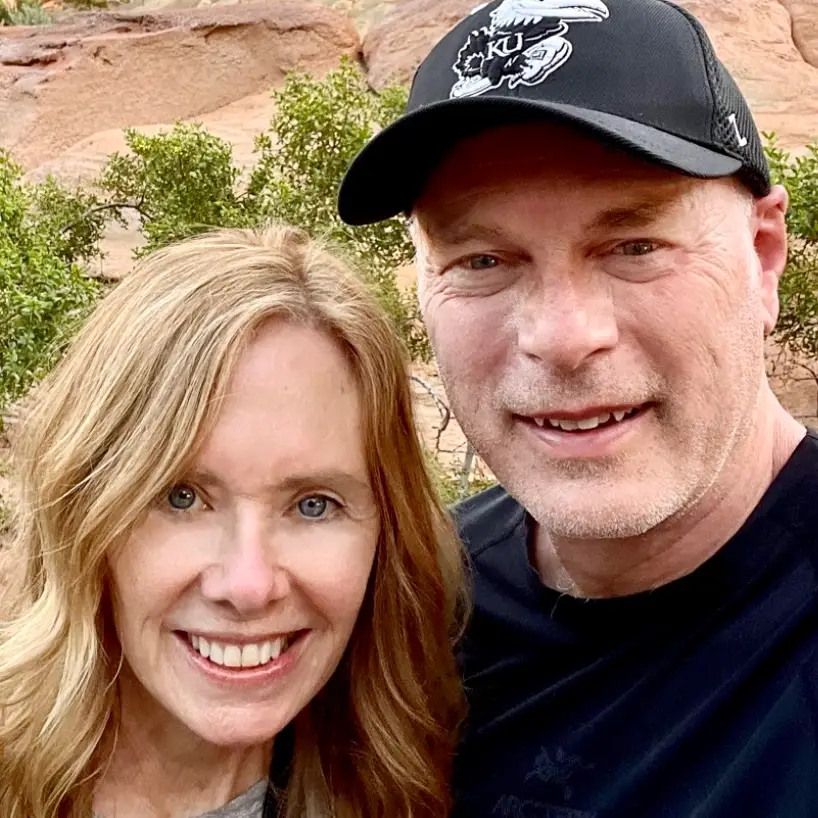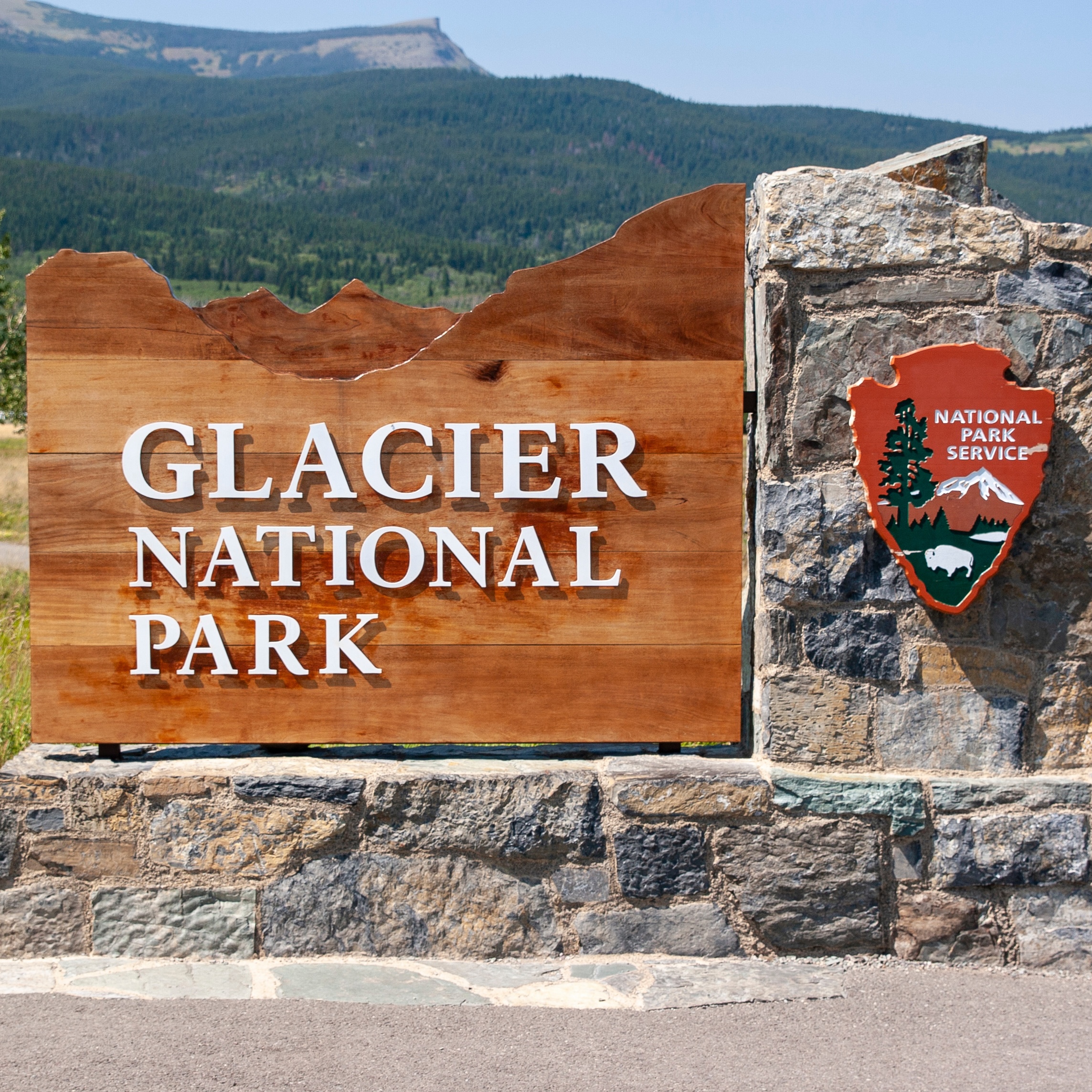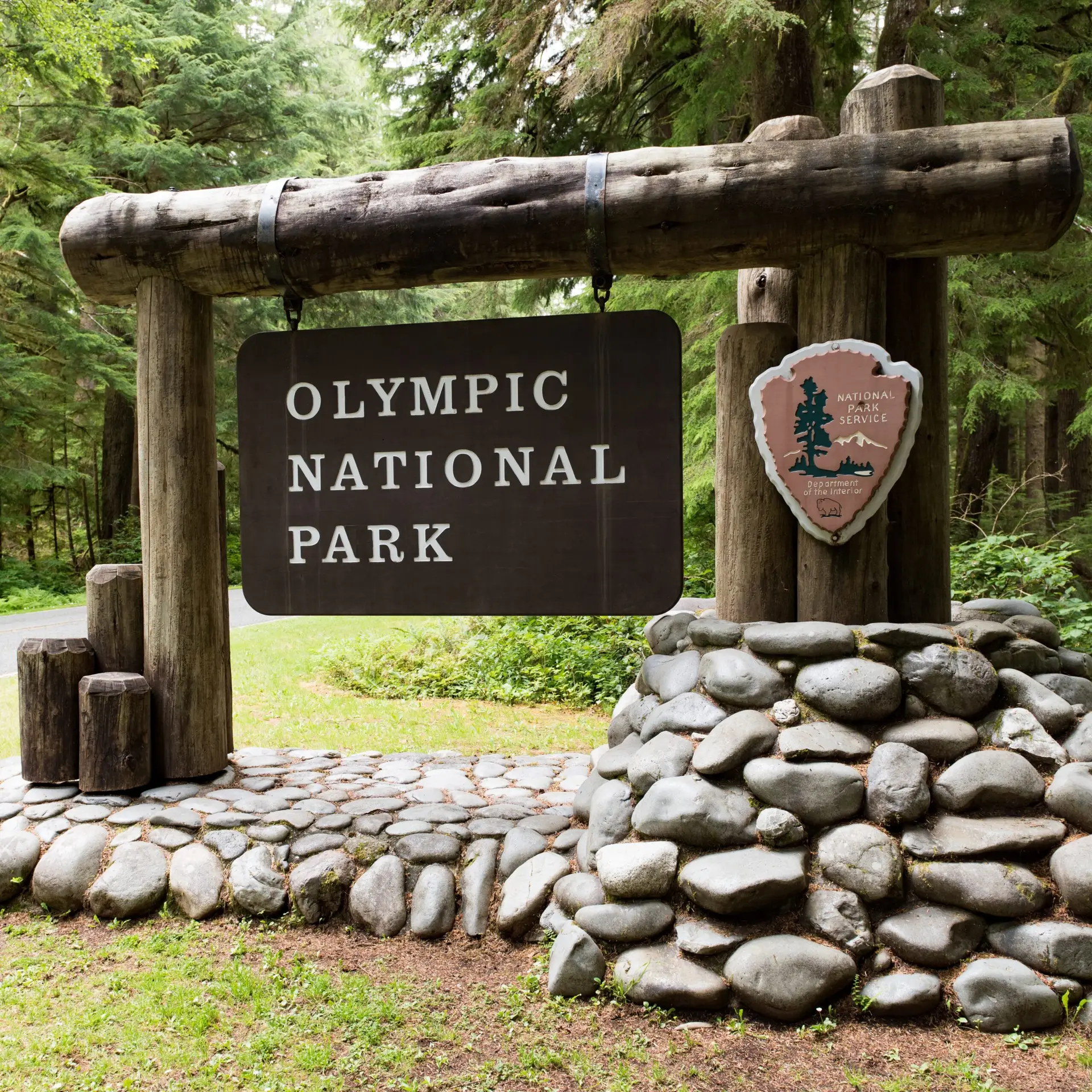No matter how often we visit Glacier, we’re always blown away by its beauty and our incredible outdoor experiences.
It’s one of the most beloved national parks in America. However, planning a summer trip there is challenging. The season is short, lodging is scarce, and access to some of the park’s most popular areas requires advance reservations. It’s a lot to figure out, and it can be confusing.
That’s why we put together this post: to share our planning tips with you and to pull together in one place much of the information you’ll need to plan your visit successfully.
Table of Contents
- Areas of the Park
- When to Go
- Where to Stay
- What to Do
- Getting Around the Park
- Bear Safety
- Pet Rules
- Entrance Fees and Passes
Areas of the Park
Below is the park map with its various regions named and highlighted. These are approximations and for general discussion purposes. This picture is a helpful reference for when you see these names mentioned throughout this post.
Where can I see a complete park map?
Click here to view a detailed park map, the same one in the brochure rangers hand out at the visitor centers and entrance stations.
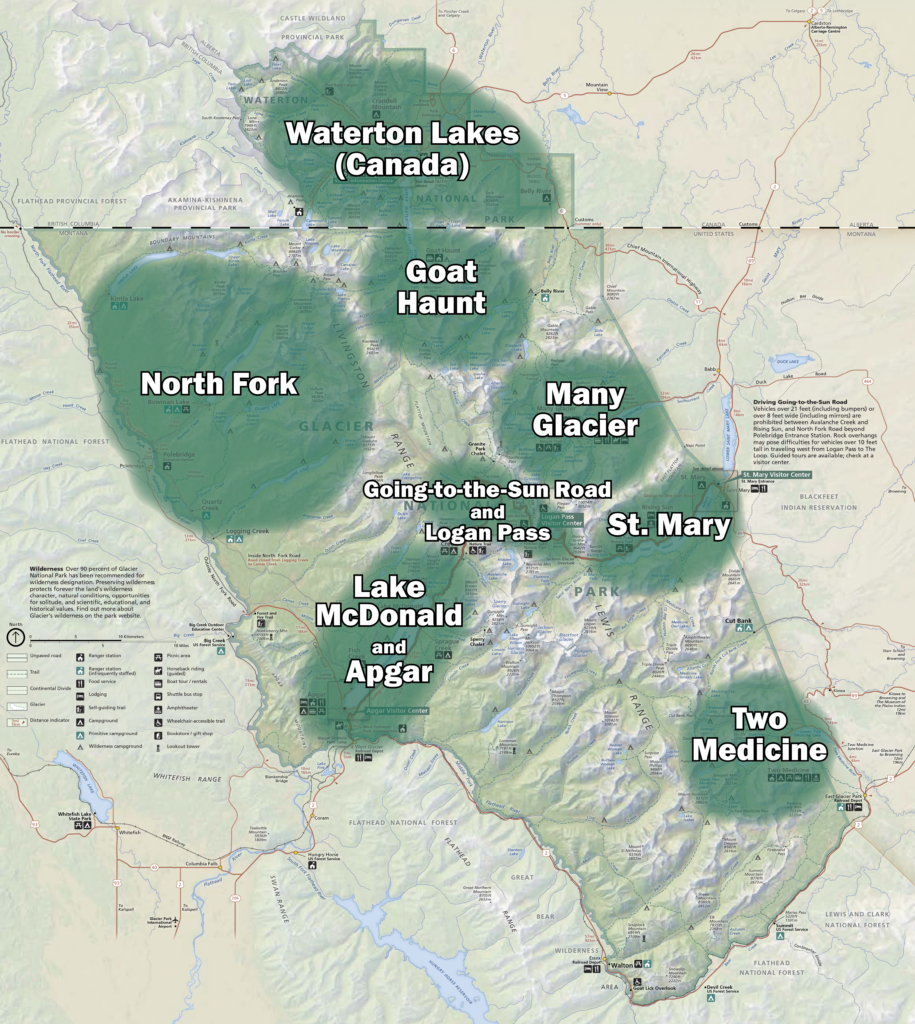
When to Go
The short answer is late June to early September. The very best time to visit, in our opinion, is mid-August.
How did we come up with this answer? Well, we had to draw a picture to explain. See below.
You’ll want to consider three things when choosing your dates to visit Glacier National Park: when the Going-to-the-Sun Road will be open, lodging availability, and the dates you’ll need a vehicle reservation to drive in some regions of the park.
Focusing on these three things will also answer most of your questions about when the best time is to hike, bike, take a boat tour, horseback ride, etc.
Going-to-the-Sun Road (GTRS)
If you can, plan your visit for when the GTSR is open.
Going-to-the-Sun Road is a 50-mile scenic highway that cuts through the center of the park, linking its east and west regions. Construction of the road began in 1921 and was completed in 1932. It’s nothing short of a stunning engineering accomplishment.
At its highest point, Logan Pass, you can stop to explore hiking trails and visit the park’s popular visitor center. However, see our discussion later in this post about parking challenges along the road.
Is driving the Going-to-the-Sun Road scary?
GTSR has a reputation for being nerve-racking for both drivers and passengers. Drivers must navigate hairpin turns and narrow passages. We have driven the road several times in both directions and yes, it requires the driver’s undivided attention. However, in the summer, thousands of drivers a day navigate the road safely by using reasonable caution.
Please note that the park restricts certain vehicles from the road. According to the park’s website, vehicles and vehicle combinations longer than 21 feet (including bumpers) or wider than 8 feet (including mirrors) are prohibited between Avalanche Creek and Rising Sun. Vehicles over 10 feet in height may have difficulty driving west from Logan Pass to the Loop due to rock overhangs. By the way, rangers are stationed at Logan Pass watching for violators, and they regularly issue citations.
Why is driving the Going-to-the-Sun Road so popular?
In essence, it’s one of the most popular attractions in the park because it provides an opportunity to experience the diverse and awe-inspiring beauty of Glacier National Park in a single, unforgettable drive.
Visiting the park when the road is open is not an absolute necessity. But being there when it’s open gives you access to many of the park’s best areas, provides you a chance to experience the drive, and can be a time-saver if you need to travel between the east and west sides of the park.
When is the Going-to-the-Sun Road open?
The dates when the park opens and closes the road vary each year depending on how long it takes to clear the snow from the previous winter and when snow accumulates in the fall. Even when the road is officially “open,” it sometimes closes briefly due to snow.
The graph below shows the range of dates the road was open for the thirty years ending in 2022. In that timeframe, the road had always been open by July 13th and had never closed for the season before September 2nd.
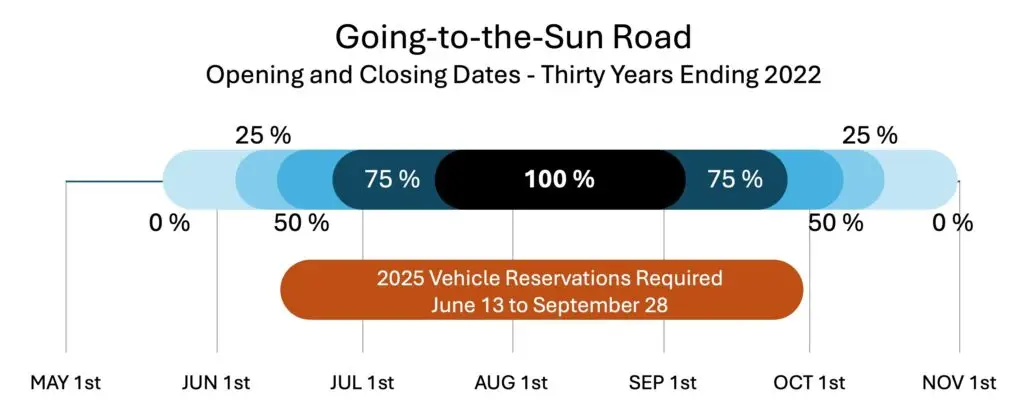
Lodging
Lodging options in or near the park begin opening for the season around mid-May to mid-June. They typically close for the season starting in late September. Hotels and motels further away from the park, such as those in Columbia Falls, Whitefish, and Kalispell, have longer operating seasons. Many in those towns are open year-round.
Vehicle Reservations
This brings us to our third item to consider: vehicle reservations. Later in this post, we discuss all the details related to vehicle reservations. We mention them in this section to make a couple of points. First, the park implemented a vehicle reservation system to manage the crush of traffic that descends on the park in the summer. Therefore, the range of dates for which the park requires vehicle reservations typically indicates the busiest days of the season.
Second, to remind you that you’ll need a vehicle reservation if you plan to drive through some areas of the park during these dates.
Once you’ve chosen the dates you’d like to visit the park, securing lodging and vehicle reservations are two of the first things to do.
Where to Stay
Staying in or very close to the park is ideal. Most of those lodging options are historic buildings, and spending the night in them is a thrill by itself. It’s also very convenient to wake up close to the activities you have planned for the day.
However, getting reservations for lodging in the park is difficult, and rates are high. Expect to pay a premium for lodging even if you stay outside the park.
Book early!
Most lodges listed below begin taking reservations up to 13 months in advance, and they usually sell out quickly.
You have three options for securing lodging: book early (as in 13 months ahead), try to catch a cancellation, or look further away for a place to stay, such as the towns of Columbia Falls, Whitefish, or Kalispell.
We’ve had luck in the past finding cancellations at even the most coveted lodges in the park. If you are late with your planning, catching a cancellation is still an option. Of course, this doesn’t always work, and if you are not flexible with your plans, you may need to book further out to lock in your lodging.
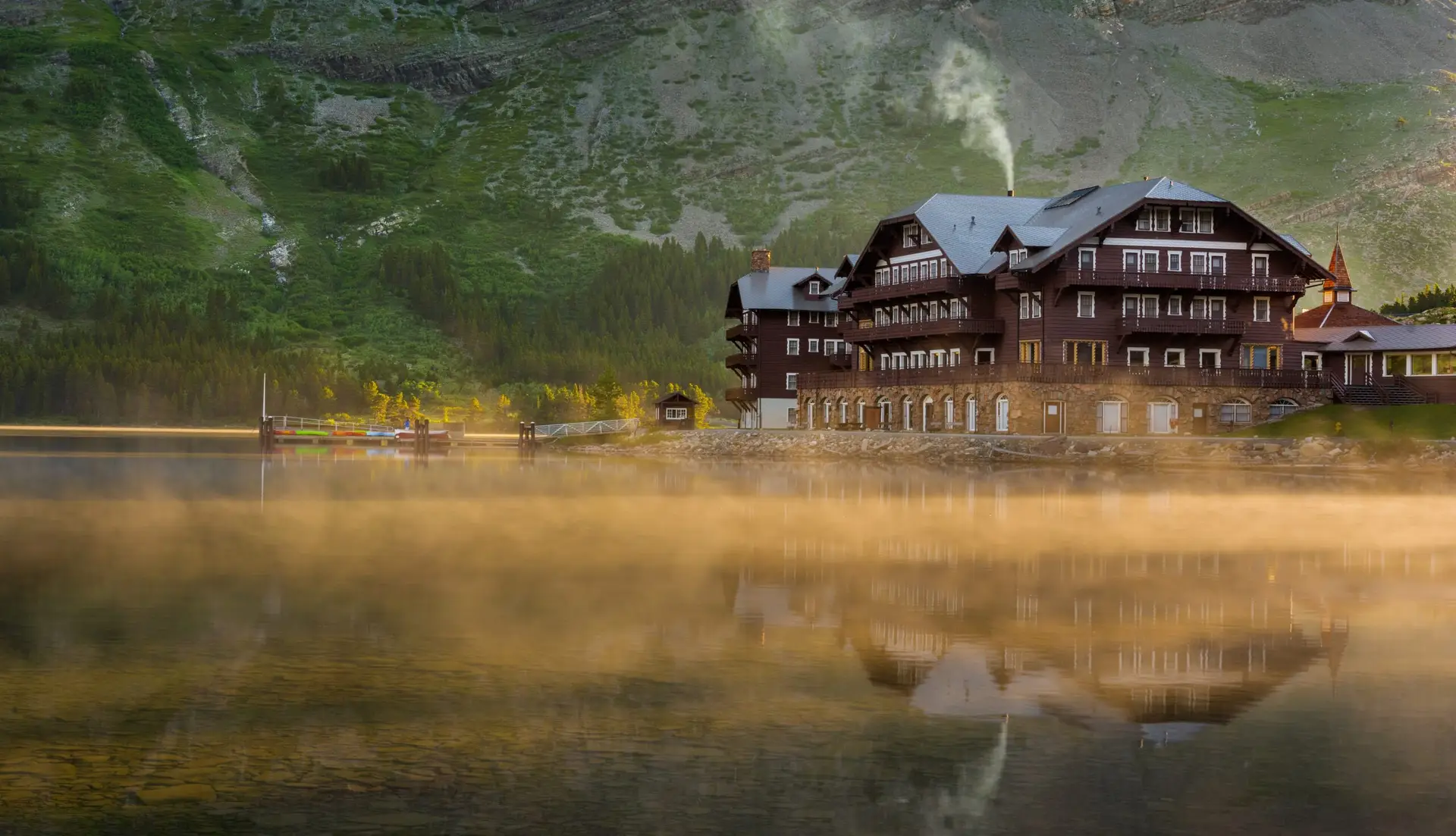
Lodging Reservations
Below are lodging options in or near Glacier National Park.
- The Village Inn at Apgar: Great location on the southwest shore of Lake McDonald
- Apgar Village Lodge and Cabins: Just steps away from the Village Inn and Eddie’s Café & Mercantile
- Lake McDonald Lodge: An iconic lodge on the shore of Lake McDonald. It’s worth your time to go in and look around even if you do not stay there.
- Motel Lake McDonald: A simple lodge located near the shores of Lake McDonald, offering basic accommodations
- Rising Sun Motor Inn: Modest motel with cabins near St. Mary Lake, conveniently located on the east side of the park along Going-to-the-Sun Road
- St. Mary Village: Full-service lodging option near the park’s east entrance
- Many Glacier Hotel: One of our favorite lodges in the entire National Park System, so many great memories
- Swiftcurrent Motor Inn and Cabins: This complex will be closed for the 2025 season due to a construction project in the Many Glacier area.
- Glacier Park Lodge: One of the best-preserved lodges in the area, built in the early days of the park by the Great Northern Railway
- LOGE Glacier: Formerly known as the Izaak Walton Inn, built in 1939, this historic property was renovated and re-opened in 2024. This lodge is just outside the park, on the south side of Highway 2.
- Belton Chalet: The Belton Chalet was the first of the historic lodges built by the Great Northern Railway to accommodate early visitors to Glacier National Park. Karen calls it a “hidden gem.”
- Prince of Wales Hotel – Canada: This hotel is in Glacier’s sister park, Waterton Lakes National Park, in Canada. We’ve included it here for anyone considering adding a visit to Waterton to their trip. If you plan to go, you’ll need proper ID to cross the border and to be able to comply with all border crossing rules.
Note: We do not have any affiliate relationships with the lodges listed in this post. Meaning, we are not paid a fee if you use these links to book a stay.
Camping Reservations
Another lodging option is to camp. Below are the campgrounds in Glacier National Park that have reservable sites.
The reservation rules may differ for each campground, so follow the links for more information. Many of them begin taking reservations 6 months in advance. Some also have first-come, first-served sites.
- Fish Creek Campground
- Apgar Campground
- Sprague Creek Campground
- Avalanche Campground
- Many Glacier Campground The Many Glacier Campground will be closed for the 2025 season due to a construction project in the Many Glacier area.
- Saint Mary Campground
- Two Medicine Campground
Glacier National Park also has a couple of backcountry chalets where you can rent rooms. Follow the links below for details about each. Guests reach both by foot: they are backpacking destinations. We’ve stayed at the Granite Park Chalet and loved it. We can’t wait to spend the night at Sperry someday.
What to Do
Hiking
Besides sitting outside at a historic lodge while looking for wildlife, hiking is our favorite activity in Glacier National Park. We’ve included in this section ten of the most popular hikes in the park. This list has a wide range of trails with varying levels of difficulty and lengths, so there are at least a couple of options for nearly everyone.
These are not the only trails in the park. For more information about other trails, see the trail maps we’ve listed below, go to the park’s hiking webpage, or consult the park’s backcountry webpage for information about backpacking.
Ten Popular Hiking Trails in Glacier National Park
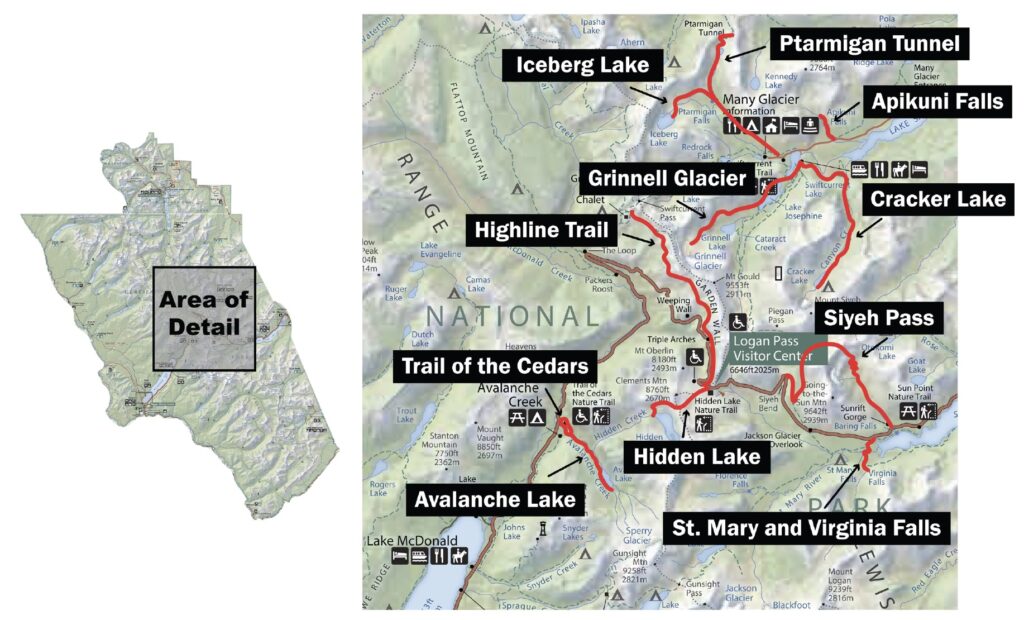
The trails below are listed in alphabetic order, not by preference. Our all-time favorite hike in the park is Many Glacier Hotel to Grinnell Glacier. The Ptarmigan Tunnel and Iceberg Lake trails would be close behind on our favorites list.
The links for these trails lead to the AllTrails.com listing for each. We do not have an affiliate relationship with AllTrails.
- Apikuni Falls 1.8 miles roundtrip – 580 feet elevation gain – short but strenuous hike to the falls
- Avalanche Lake 5.9 miles roundtrip – 757 feet elevation gain – moderately strenuous hike to a beautiful alpine lake
- Cracker Lake 12.8 miles roundtrip – 1,712 feet elevation gain – spectacular lake setting at the destination
- Grinnell Glacier 10 to 12 miles roundtrip depending on the route you take and how much you want to explore at the destination – 2,047 feet elevation gain – Likely the most popular hike in the park, get an early start if you want to avoid the crowds. A boat tour across Swiftcurrent and Josephine Lakes will reduce the length by two miles each way.
- Hidden Lake From the Logan Pass Visitor Center to the overlook is 2.7 miles roundtrip and 551 feet elevation gain. Hiking all the way to the lake from the Visitor Center is 5.1 miles roundtrip and 1,338 feet elevation gain.
- Highline Trail This trail is the hiking equivalent of the Going-to-the-Sun Road – when hiked between The Loop and Logan Pass Visitor Center with a shuttle ride, the trail is about 12 miles with 1,500 feet elevation gain. You could also hike it out-and-back from the Logan Pass Visitor Center as far as you’d like.
- Iceberg Lake 9.6 miles roundtrip – 1,459 feet elevation gain – a moderately challenging hike to a beautiful alpine lake destination
- Ptarmigan Tunnel 10.6 miles roundtrip – 2,362 feet elevation gain – cool historic tunnel at the top of the trail with stunning views of the park to the north and west on the other side
- St. Mary and Virginia Falls 3.1 miles roundtrip – 452 feet elevation gain – we recommend taking the shuttle to the trailhead
- Siyeh Pass 9.8 miles as a one-way open loop west to east – 2,244 feet elevation gain – stunning views – less crowded than many of the other alpine trails in the park
- Trail of the Cedars One mile loop and 50 feet elevation gain – easiest trail on this list – a nature walk worth doing
Trail maps
Below is a list of trail maps produced by the National Park Service. Click on any title to view the map.
- Lake McDonald Valley
- St. Mary Valley and Logan Pass
- Two Medicine Valley
- Many Glacier
- North Fork and Goat Haunt
A note about the weather
Glacier National Park is mountainous, and its elevation varies significantly, so the weather there can change quickly and dramatically. Be prepared for any conditions, especially when hiking.
We’ve learned the hard way the importance of packing layers in Glacier. Once, on a hike up to Grinnell Glacier, we were caught unprepared for the cold wind and sleet we ran into in August, no less. Luckily, we had those cheap emergency ponchos tucked away in our backpacks, which ended up saving us, barely.
When you hike, it’s a good idea to have the ten essentials with you, including waterproof and windproof gear, a warm fleece, and a hat and gloves. And, of course, also carry sun protection even if it looks like it will be overcast all day.
Other Popular Activities
Hiking is not the only activity in the park. We’ve listed below several other activities that are popular with visitors, as well as links to where you can find more information about each.
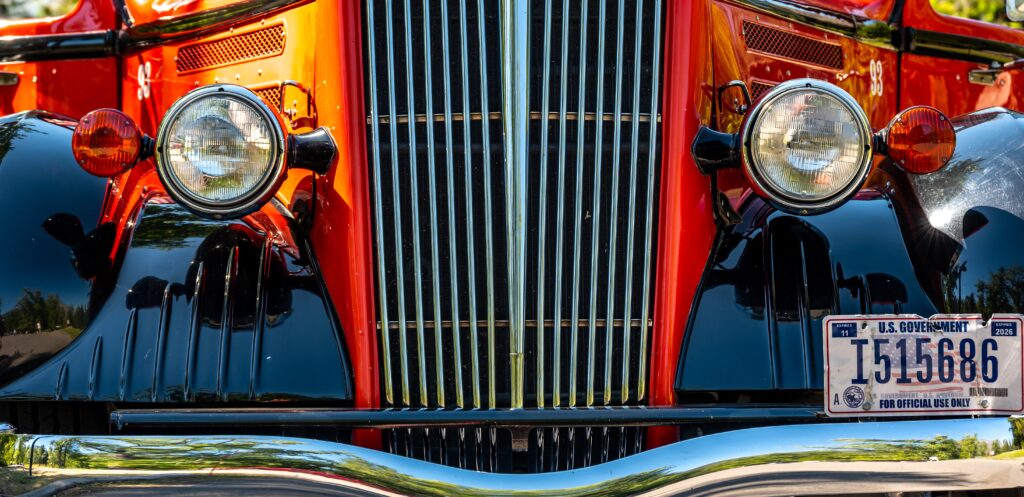
- Red Bus Tours
- Red Bus Tours offer a unique way to explore the park’s stunning scenery. Since the 1930s, these iconic red buses, known for their open-top design, have taken visitors on tours along the Going-to-the-Sun Road and other scenic routes throughout the park. Check out the concessionaire’s website for more information.
- Boat Tours
- For a peaceful and scenic way to explore the park’s stunning lakes, consider a boat tour or renting a kayak or canoe. The park’s boating concessionaire’s website has information about locations, prices, and making a reservation.
- Horseback Riding
- Horseback riding is a great way to experience the park. Swan Mountain Outfitters offers trips of various lengths out of Apgar, Lake McDonald, and Many Glacier. Trips range in experience level from beginner to advanced. Consult the outfitter’s website to find answers to your questions, including age limits.
- Rafting
- Rafting one of the rivers adjacent to the park is always a thrill on a warm summer day. Several raft companies provide commercially guided raft trips on the Middle Fork and North Fork of the Flathead River. Both rivers are within the Flathead Wild and Scenic River designation and are jointly managed by Glacier National Park and the Flathead National Forest. See the park’s rafting webpage for a list of companies that have rafting permits.
- Biking
- Biking in the park has become an extremely popular activity. However, due to several factors, including increased traffic, the park may restrict biking in certain areas and times. Learn more about biking opportunities in the park on the park’s bicycling webpage.
- Polebridge Mercantile
- Polebridge Mercantile is a rustic general store just outside the park’s Polebridge Entrance station in the North Fork area. Established in 1914, this off-grid merchant is known for its baked goods and locally made products. The mercantile is hugely popular with locals and park visitors, expect a line to get in during peak season. If you are ever in this area of the park, you have to stop at the mercantile. We recommend their famous huckleberry bear claws. Pro tip: buy more bear claws than you think you could possibly eat.
Getting Around the Park
This section discusses the 2025 Vehicle Reservation program, other vehicle restrictions in the park, and the challenges of finding parking along Going-to-the-Sun Road and at Logan Pass. It also outlines shuttle options as alternatives to getting a vehicle reservation or trying to find parking.
Vehicle Reservations and Restrictions
In the summer 2025, three areas of the park will have limitations on vehicle travel: the west side of Going-to-the-Sun Road, the North Fork area, and the Many Glacier area. Below is a brief overview of each.
Much of the information in this section came from the park’s website and has been summarized in places. For more information, visit the park’s vehicle reservation webpage.

West Side of Going-to-the-Sun Road (GTSR)
From June 13 to September 28, 2025, each vehicle driving beyond the Apgar Village area on the GTSR from 7 a.m. to 3 p.m. must have a vehicle reservation. This is in addition to needing an entrance pass. You’ll need both. See more information about entrance fees and passes later in this post.
North Fork Area
For those same dates, June 13 to September 28, 2025, each vehicle driving into the park at the Polebridge Entrance in the North Fork area of the park from 7 a.m. to 3 p.m. must have a vehicle reservation – and an entrance pass.
Key details about vehicle reservation requirements in 2025
- A portion of the vehicle reservations will be available 120 days or approximately four months in advance, starting on February 12, 2025, at 8 am MST on a daily rolling basis.
- Next Day vehicle reservations will be available at 7 pm MDT for next-day entry starting on June 12, 2025 on a daily rolling basis.
- Vehicle reservations can only be booked on Recreation.gov
- Visitors will enter the park according to the time block they have reserved and can remain in the park for as long as they like on the day of their reservation.
- Visitors who miss their reserved time block can enter after 3 p.m.
- Multiple time blocks will be available between 7 a.m. and 3 p.m.
- Visitors with lodging, camping, transportation, or commercial activity reservations can access their intended service within the Going-to-the-Sun Road reservation area with proof of their reservation.
- Visitors may enter these areas without a reservation before or after reservation hours.
- No other areas of the park will require vehicle reservations in 2025. However, the Many Glacier area will have a special limitation in 2025 – see next section for those details.
Many Glacier Area
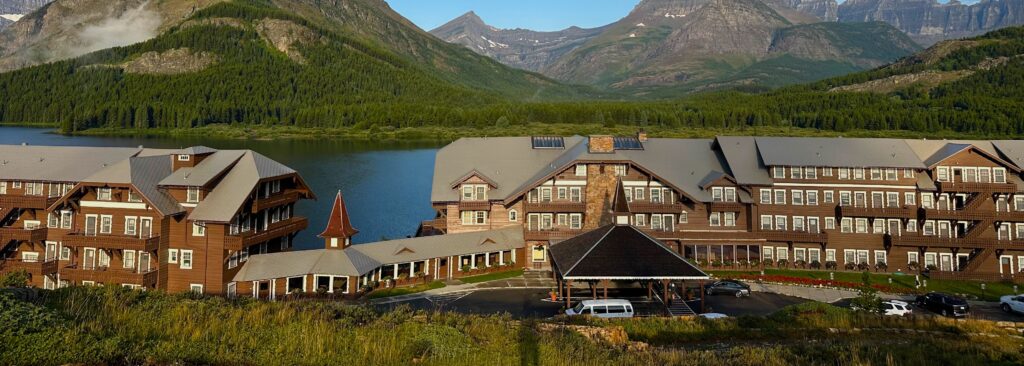
As a result of construction in the area, about half of the parking in the Many Glacier Valley will not be available in 2025. Therefore, visitor access to the area will be greatly limited.
How the 2025 construction project will affect visitors
- The park will restrict personal vehicle access into Many Glacier and provide a temporary shuttle service for hikers to access Many Glacier and Swiftcurrent from July 1, 2025, to September 21, 2025.
- This temporary hiker shuttle service, which will be accessed through a ticket purchased on Recreation.gov, is not part of the vehicle reservation system, but a temporary solution for day hikers to access Many Glacier Valley during construction.
- In 2025, the Many Glacier Hotel, Swan Mountain Outfitters and Glacier Park Boat Company will operate as usual.
- Visitors with a lodging reservation will be provided access details with their lodging reservation confirmation.
- Visitors with horseback and boating reservations can drive into the valley by showing their reservation confirmation at the park entrance during hours when the entrance is staffed.
- The only parking available during the closure will be at Many Glacier Hotel, and will be set aside for visitors with lodging, horseback riding and boating reservations between July 1 and September 21, 2025.
Read the park’s announcement here for more information about access to the Many Glacier area in 2025.
Parking Along Going-to-the-Sun Road (GTSR) and At Logan Pass
Finding parking along GTSR and at Logan Pass in the summer can be challenging due to high traffic and limited parking capacity.
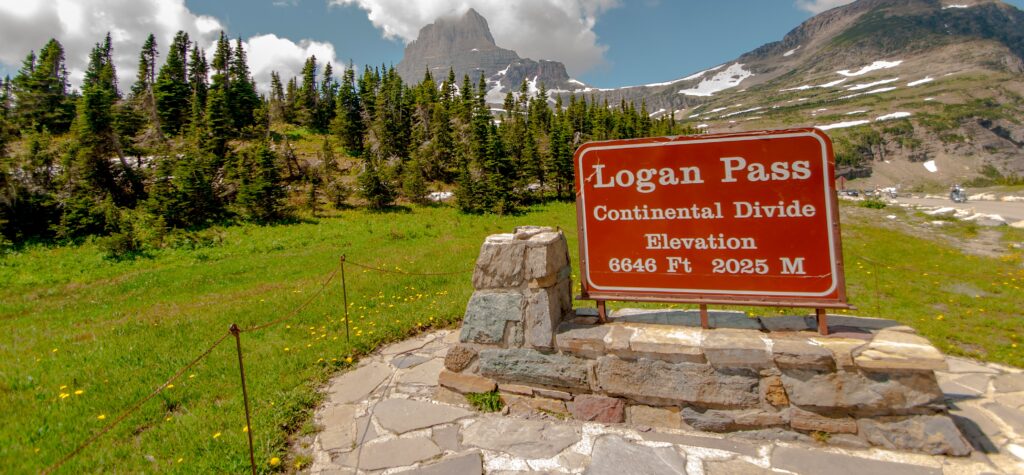
Most of Glacier National Park’s 3+ million annual visitors arrive between late June and early September, and GTSR is one of the park’s main attractions. While the vehicle reservation program has reduced traffic along GTSR in recent years, the road’s pullouts and viewpoints often fill up by mid-morning.
Logan Pass, the highest point on the road, is particularly in demand as it provides access to popular trails like the Hidden Lake Overlook and the Highline Trail. With only about 230 parking spaces, competition for spots at Logan Pass is fierce.
Visitors arriving at the Logan Pass Visitor Center parking lot after early morning are usually turned away. As a result, we strongly encourage you to arrive early to your destination if it is along GTSR, consider taking a shuttle or a Red Bus into the park, or carpool to avoid parking frustrations.
Park Shuttles
Rather than deal with the traffic, consider taking a shuttle to get around the park.
Click on the links below for more details. Recheck these links regularly if reservations or schedules for the coming year are unavailable.
Free Shuttles
- Full Shuttle Service – Runs 8 am to 7 pm, 7 days a week when GTSR is open. See all the details here.
- Express Shuttle Service – Morning express service to Logan Pass from Apgar Visitor Center in the west and St. Mary Visitor Center in the east.
- Hiker-Biker Shuttle Service – offers shuttle stops at Apgar Visitor Center, Lake McDonald Lodge, and Avalanche Creek only in the spring before the GTSR opens
Shuttles for a Fee
- Many Glacier Hiker’s Shuttle provided by Xanterra – In the past, this shuttle ran multiple times per day (from July 1st to mid-September) from Swiftcurrent Motor Inn and Many Glacier Hotel to St. Mary Visitor Center. However, check the link for most current information as the park has imposed vehicle restrictions in the Many Glacier area for 2025. It’s not clear how this will affect the Many Glacier Hiker Shuttle operations.
- Temporary Many Glacier Hiker Shuttle in 2025 – This is a different hiker shuttle than the one in the bullet point above. As of this writing, the park had not released details about how to purchase a ticket for this shuttle. Read the park’s announcement here for more details.
Drive Times and Distances
When planning your activities in the park, consider how long it will take you to drive from one place to the next. Glacier is a huge park and visitors are often surprised at how much time they spend in the car getting around.
Below is a list of approximate driving times and distances between major hubs in and around the park. These drive times are based on normal traffic conditions. Click here to see a park map showing these times and distances.
- West Entrance <> Polebridge Entrance – 42 minutes, 27 miles
- West Entrance <> St. Mary Village – 95 to 120 minutes, 50 miles
- West Entrance <> East Glacier Park – 60 minutes, 56 miles
- St. Mary Village <> East Glacier Park – 42 minutes, 30 miles
- St. Mary Village <> Babb, Montana – 12 minutes, 10 miles
- See notes about vehicle restrictions along this road in 2025
- Babb, Montana <> Many Glacier Hotel – 23 minutes, 12 miles
- Babb, Montana <> Prince of Wales Hotel, Canada – 51 minutes, 38 miles
- Involves an international border crossing
Bear Safety
It’s good practice always to be aware of your surroundings and any wildlife nearby wherever you are in the park. Fatal encounters with bears, while not frequent, have happened in Glacier National Park. When hiking in the park, take bear spray, keep it accessible, and know how to use it.
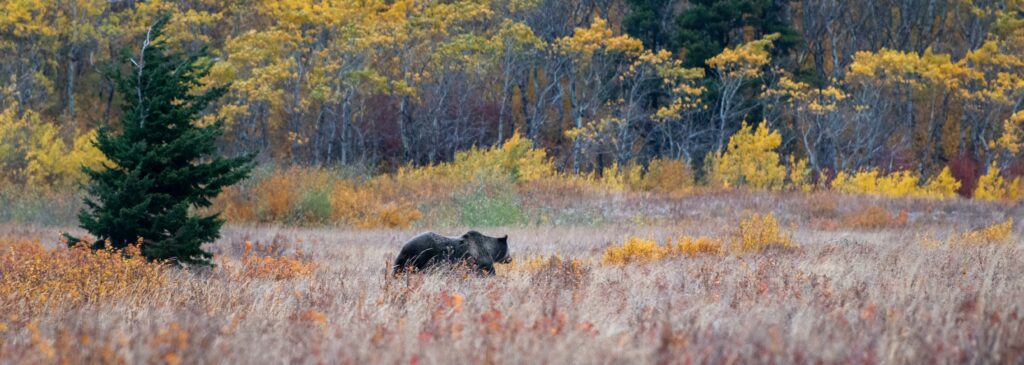
Your primary source for bear safety information should be the park’s website.
The park’s Bear Safety page says: Never intentionally get close to a bear. Individual bears have their own personal space requirements, which vary depending on their mood. Each will react differently, and their behavior cannot be predicted. All bears are dangerous and should be respected.
We encourage you to read all the information on the park’s Bear Safety page if you plan on visiting the park.
Notes about bear spray
- Read the instructions on the side of your bear spray canister before encountering a bear. The bear will not wait while you look for your reading glasses or try to figure out how to take the safety off the trigger.
- Keep your bear spray accessible when hiking. It is not accessible when it is zipped in your backpack. We keep ours in a carrier on our belts or in the water bottle pocket of our backpacks. Karen often carries it in her hand while hiking in bear country.
- Bear spray expires, so check the expiration date on your canister and buy new spray when needed.
- If you have expired bear spray, this is an excellent opportunity to practice shooting it in a safe place away from other people and animals. Practicing in a safe, stress-free environment will give you confidence if you ever need to use it on the trail.
- You cannot fly with bear spray, neither in your carry-on nor in your checked luggage. If you are flying as part of your trip to Glacier, you’ll have to buy it along the way after your flight.
Pet Rules
Pet rules vary by national park. Knowing the specific rules for Glacier can help you with planning and save you a lot of hassle once you get there. Visit the park’s pet rule page for a complete list of rules.
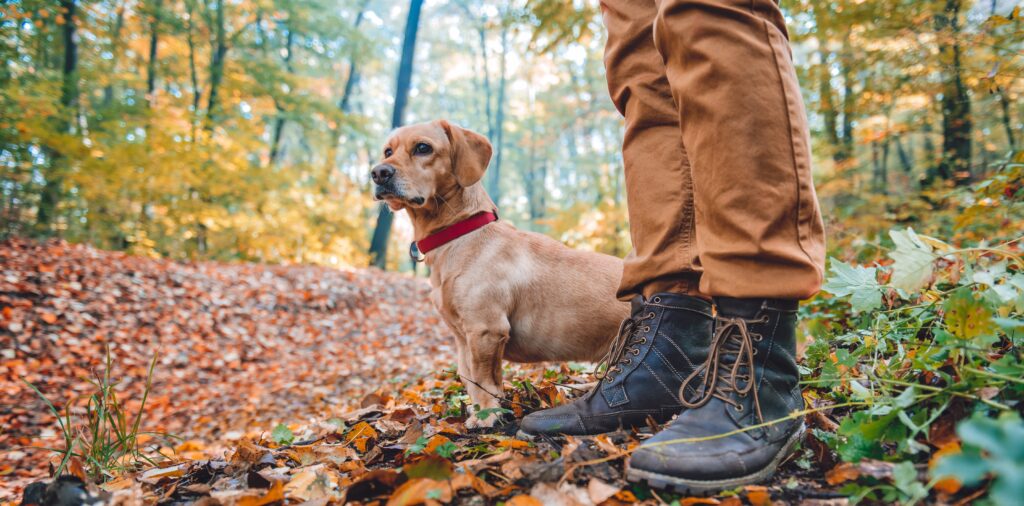
Below are a few of the most relevant pet rules from the park’s website.
- Pets are not permitted on trails, along lake shores outside of developed locations, in the backcountry, or in any building.
- Pets must be on a leash no longer than 6 feet (1.8 m), under physical restraint, or caged at all times, including while in open-bed pickup trucks.
- When roads are closed to vehicle traffic, they are considered a backcountry trail and dogs are not allowed.
- Pets are allowed in developed areas such as: in your cars while driving park roads, frontcountry campgrounds, picnic areas, along roads when you are stopped, in parking areas, and in boats on lakes where motorized watercraft are permitted.
Entrance Fees and Passes
Now for some cheery news: you might be able to save money on your entrance fee!

You’ll need an entrance pass to enter the park, even if you already have a vehicle reservation. If you don’t have an entrance pass before arriving at the park entrance station, you can buy one from the ranger at the booth.
Listed below are the entrance pass options. Please read through the entire list before deciding which to choose because you may be eligible for a free or reduced fee pass. Click on each heading below for more information about those options.
Glacier National Park Passes
- Standard Pass $20-$35, depending on the time of year. The Standard Pass is good for seven consecutive days and up to four occupants in your vehicle. The park’s website does not indicate when the higher fee applies, but it’s safe to assume it will be $35 during the busy summer season.
- Annual Pass $70 The Glacier National Park Annual Pass is only valid in Glacier whereas the America the Beautiful Passes below are valid in all national parks and most federal lands such as National Forests.
America the Beautiful Passes
- Annual Pass (Everyone is eligible) $80
- Senior Annual Pass (US citizens and permanent residents 62+ years old) $20
- Senior Lifetime Pass US citizens and permanent residents 62+ years old $80
- Military Annual (active US military) Free
- Military Lifetime (Gold Star Family members and Veterans) Free
- Access Pass (US citizens and permanent residents with permanent disability) Free
- 4th Grade Pass (US 4th graders) Free
- Volunteer Pass (Federal recreation site volunteers with 250 service hours) Free
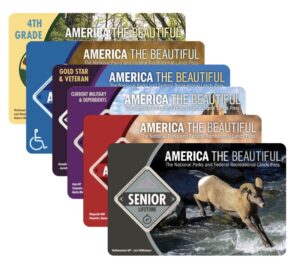
America the Beautiful Passes are non-refundable, non-transferable and cannot be replaced if lost or stolen. Passholders must show valid photo identification (ID) with each pass.
Important note: If you qualify for one of the free passes above, you must get it before you arrive at the park. Parks usually don’t issue the free passes. Follow this link to get your free pass. Do this well in advance of your trip to make sure you receive your pass in time. For volunteers, check with the entity for which you volunteer for instructions on how to get your free pass.
